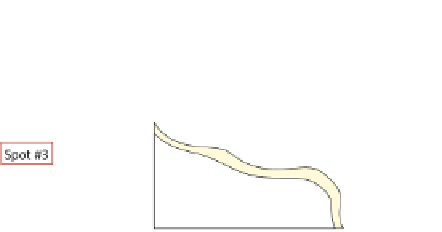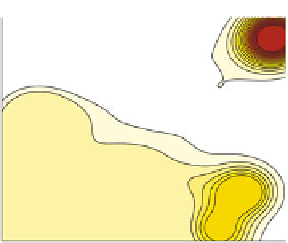Database Reference
In-Depth Information
150
100
50
0
0
50
100
150
Fig. 12.1
Figure on the
left
shows the trajectory of a bald eagle over 3 years. Each
yellow pin
is
a recorded GPS locations. Figure on the
right
shows the density map of all the locations in the
trajectory.
Periodica
first detects
dense areas
as reference spots and then find periodicity for each
reference spot [
22
]
if an object fails to follow regular periodic behaviors, it could be a signal of abnormal
environment change or an accident.
In this section, we will first introduce how to automatically detect periods in a
trajectory. Then, we will discuss the methods to mine frequent periodic patterns from
a trajectory. Lastly, we will show how to use periodic patterns for future movement
prediction.
3.1
Automatic Discovery of Periodicity in Movements
A periodic behavior can be loosely defined as the repeating activities at certain
locations with
regular time intervals
. So the mining task will be, given a trajectory,
find those locations and corresponding periods (i.e., regular time intervals). This is
a challenging task because a real-life moving object never strictly follows a single
given periodic pattern. For example, birds never follow exactly the same migration
path every year. Their migration routes are strongly affected by weather conditions
and thus could be substantially different from previous years. Meanwhile, even
though birds generally stay in north in the summer, it is not the case that they stay
at exactly the same locations on exactly the same days of the year as previous years.
Therefore, “
north
” is a fairly vague geo-concept that is hard to be modeled. Moreover,
birds could have multiple interleaved periodic behaviors at different spatiotemporal
granularities, as a result of
daily
periodic hunting behaviors, combined with
yearly
migration behaviors.
Li et al. [
22
] propose
Periodica
to handle the aforementioned challenges. One of
their key observations is that the
binary in-and-out patterns with respect to different
reference spots
can reliably reveal movement periodicity.
Periodica
is done in two
steps. In the first step, the trajectory points are clustered based on the spatial densities
















































